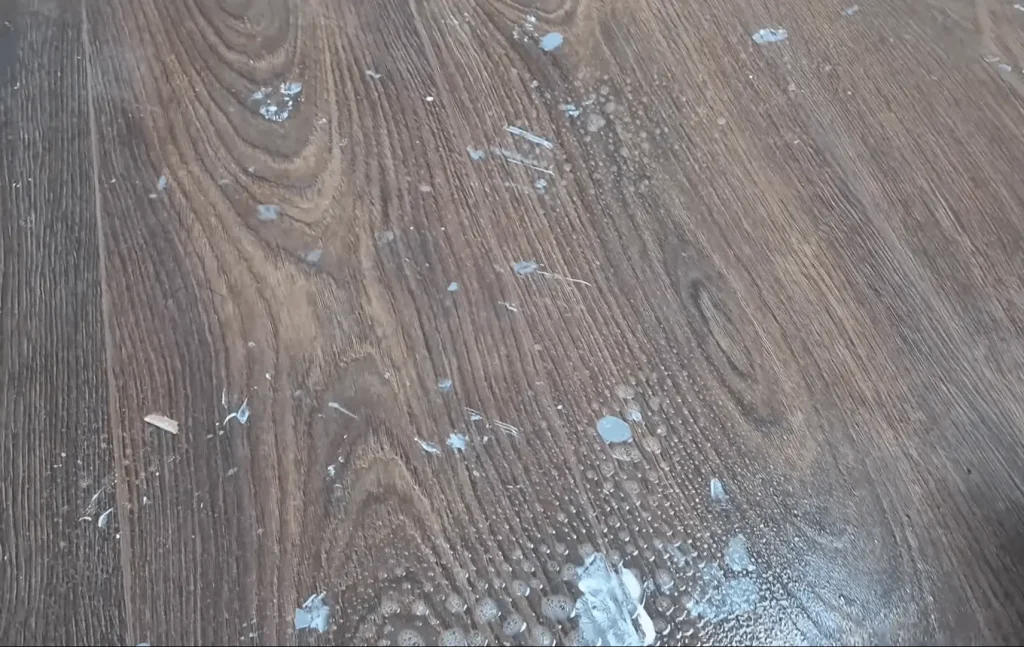How to Get Paint Off from Laminate Floor: Effective Methods
Laminate flooring has become a popular choice for homeowners due to its affordability, durability, and variety of styles.
Whether you’re renovating an old home or designing a new one, laminate flooring offers the perfect blend of aesthetics and functionality.
However, one challenge that many people face is dealing with paint spills. Removing paint from laminate flooring can be tricky, and doing it wrong might damage the floor.
To remove paint from laminate flooring, start by gently scraping off dried paint with a plastic scraper, ensuring not to scratch the surface. For stubborn stains, apply a small amount of rubbing alcohol or nail polish remover to a cloth and rub the stain gently. Always test on a small area first to avoid damage, and finish by wiping clean with warm, soapy water.
In this guide, we’ll walk you through everything you need to know about laminate flooring, the types of paint that can affect it, and the best methods for removing paint without causing harm.
What is Laminate Flooring?
Laminate flooring is a multi-layer synthetic flooring product fused with a lamination process.
It simulates wood (or sometimes stone) with a photographic appliqué layer under a clear protective layer.
The inner core layer is usually composed of melamine resin and fiberboard materials.
One of the main reasons laminate flooring is so popular is its versatility. It can mimic the look of hardwood, stone, or tile at a fraction of the cost.
Additionally, it is known for being easy to install and maintain, making it a favorite for DIY enthusiasts.
Different Types of Laminate Flooring
Laminate flooring comes in various types, each offering different benefits. The most common types include:
- High-Pressure Laminate (HPL): Known for its durability, HPL is made by bonding several layers under high pressure. It’s a great choice for high-traffic areas.
- Direct Pressure Laminate (DPL): This is the most common type found in homes. It’s less durable than HPL but more affordable.
- Embossed Laminate: This type has a textured finish that mimics the look and feel of real wood or stone.
- Waterproof Laminate: Ideal for kitchens and bathrooms, this type offers enhanced water resistance.
Each type has its unique features, so it’s essential to choose the one that best suits your needs and the specific area where it will be installed.
Why It’s Important to Be Careful When Removing Paint
Laminate flooring, while durable, can be sensitive to certain chemicals and methods used in paint removal.
Using the wrong technique or product can cause discoloration, scratches, or even structural damage to the floor.
Paint can seep into the seams and edges of the laminate planks, making it harder to remove. Additionally, abrasive methods can wear down the protective layer, making the floor more susceptible to future damage.
Therefore, it’s crucial to use the right approach to maintain the integrity and appearance of your laminate flooring.
Types of Paint and How They Affect Laminate Flooring
Different types of paint can have varying effects on laminate flooring. Here are the most common types you might encounter:
- Water-Based Paint: This type is relatively easy to clean up when wet but can be tricky once dried. It’s less likely to cause long-term damage.
- Oil-Based Paint: Known for its durability and glossy finish, oil-based paint can be challenging to remove from laminate floors and may require stronger solvents.
- Latex Paint: Similar to water-based paint, latex is easy to clean when wet. However, once it dries, it can be stubborn and might require careful scraping.
- Acrylic Paint: Acrylic paint, commonly used for arts and crafts, can be removed with water when wet but becomes more difficult to handle when dry.
Understanding the type of paint you’re dealing with will help you choose the most effective and safest method for removal.
Preparing for Paint Removal
Before you begin removing paint from your laminate floor, it’s essential to prepare properly to avoid any accidental damage. Here’s what you need to do:
Gathering Necessary Tools and Materials
Having the right tools on hand will make the process smoother. You’ll need items such as:
- Soft cloths or paper towels
- Plastic scraper or putty knife
- Mild detergent
- Warm water
- Vinegar and baking soda (for home remedies)
- Rubbing alcohol or nail polish remover
- Safety goggles and gloves
Safety Precautions
Always prioritize safety when working with chemicals.
Ensure the room is well-ventilated, and wear gloves and goggles to protect your skin and eyes from any splashes.
If you’re using a solvent, make sure to read the label and follow the manufacturer’s instructions carefully.
Testing a Small Area First
Before applying any cleaning solution or method to the entire paint spill, test it on a small, inconspicuous area of the laminate floor.
This will help you determine if the method is safe and effective without risking significant damage.
Step-by-Step Guide to Removing Paint from Laminate Floor

Removing paint from laminate flooring can be straightforward if you follow these steps tailored to the paint’s condition.
1 – For Fresh Paint
If the paint is still wet, quick action is crucial.
Use a soft cloth or paper towel to blot (not wipe) the paint gently.
Avoid spreading the paint further. Once most of the paint is absorbed, use a mild detergent mixed with warm water to clean the residue.
2 – For Dried Paint
For paint that has dried, start by gently scraping off as much of the paint as possible using a plastic scraper or putty knife.
Be careful not to scratch the surface.
After scraping, dampen a cloth with warm water and a small amount of mild detergent, and gently rub the area to remove any remaining paint.
3 – For Stubborn Paint Stains
If the paint stain persists, more robust methods may be required.
Dampen a cloth with rubbing alcohol or nail polish remover, and apply it to the stained area.
Let it sit for a few minutes to soften the paint. Then, use a plastic scraper to gently remove the softened paint. Wipe the area clean with a cloth and warm water once the paint is gone.
Alternative Methods for Paint Removal
Sometimes, household items can be surprisingly effective for removing paint from laminate floors. Here are some alternative methods you can try:
Home Remedies (Vinegar, Baking Soda)
Vinegar and baking soda are excellent for tackling paint stains naturally.
Make a paste using equal parts of baking soda and water.
Apply the paste to the paint stain and let it sit for a few minutes. Scrub gently with a soft cloth or sponge, then wipe clean with warm water.
Alternatively, mix vinegar with warm water and use it to dampen the stain before scrubbing.
Using Rubbing Alcohol or Nail Polish Remover
Rubbing alcohol and nail polish remover are effective for tougher stains.
Apply a small amount to a cloth and rub the paint stain gently.
These solvents help break down the paint without damaging the laminate floor. However, always test on a small area first to ensure they don’t cause discoloration.
Pros and Cons of Each Method
Each paint removal method has its advantages and disadvantages.
Home remedies like vinegar and baking soda are natural and non-toxic but may require more elbow grease.
Rubbing alcohol and nail polish remover are more effective on tough stains but can be harsh if not used carefully.
Weighing these pros and cons can help you choose the best method for your situation.
Conclusion
Removing paint from laminate flooring doesn’t have to be a daunting task. With the right tools, methods, and precautions, you can effectively clean your floors without causing damage.
Whether you opt for a gentle home remedy or a more robust solvent, always remember to test a small area first and proceed with care.
By following these steps, you can keep your laminate flooring looking pristine and extend its lifespan. So the next time you face a paint spill, you’ll be well-prepared to tackle it with confidence.
Related Articles:
- How to Get Stains Out of Marble: Easy and Effective Tips
- How to Remove Dog Urine Smell from Floor Naturally & Safely

